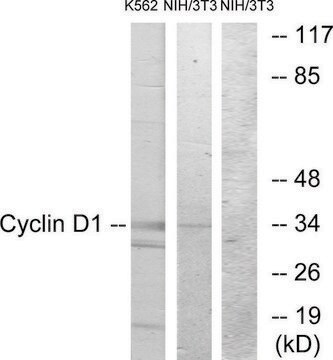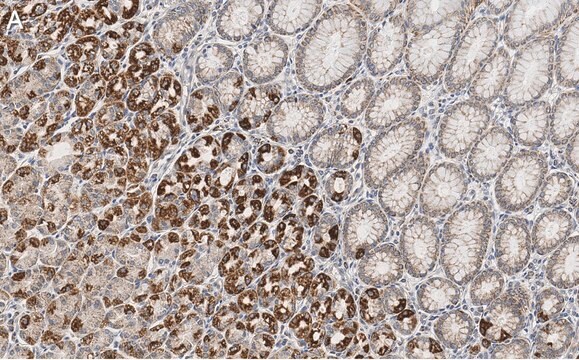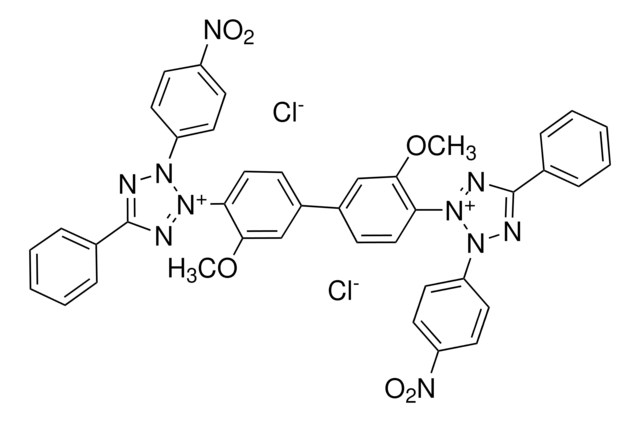CC12
Anti-Cyclin D1 (Ab-3) Mouse mAb (DCS-6)
liquid, clone DCS-6, Calbiochem®
Synonym(s):
Anti-Bcl-1, Anti-PRAD-1
Sign Into View Organizational & Contract Pricing
Select a Size
All Photos(1)
Select a Size
Change View
About This Item
UNSPSC Code:
12352203
NACRES:
NA.41
Recommended Products
biological source
mouse
Quality Level
antibody form
purified antibody
antibody product type
primary antibodies
clone
DCS-6, monoclonal
form
liquid
contains
≤0.1% sodium azide as preservative
species reactivity
human, mouse, rat
manufacturer/tradename
Calbiochem®
storage condition
do not freeze
General description
Purified mouse monoclonal antibody generated by immunizing mice with the specified immunogen and fusing splenocytes with NS/1 mouse myeloma cells. Recognizes the cyclin D1 protein.
Recognizes cyclin D1 in MCF-7 and A431 cells. Does not react with cyclins D2 and D3.
This Anti-Cyclin D1 (Ab-3) Mouse mAb (DCS-6) is validated for use in FC, Frozen Sections, Immunoblotting, IF, IP, Neutralization Studies, Paraffin Sections for the detection of Cyclin D1 (Ab-3).
Immunogen
Human
recombinant human cyclin D1
Application
Flow Cytometry (5 µg/ml; Cat. No. CC12, CC12F)
Frozen Sections (see application references)
Immunoblotting (1 µg/ml)
Immunofluorescence (5 µg/ml; Cat. No. CC12, CC12F)
Immunoprecipitation (see application references)
Neutralization Studies (see application references)
Paraffin Sections (5 µg/ml, heat pre-treatment required)
Frozen Sections (see application references)
Immunoblotting (1 µg/ml)
Immunofluorescence (5 µg/ml; Cat. No. CC12, CC12F)
Immunoprecipitation (see application references)
Neutralization Studies (see application references)
Paraffin Sections (5 µg/ml, heat pre-treatment required)
Packaging
Please refer to vial label for lot-specific concentration.
Warning
Toxicity: Standard Handling (A)
Physical form
In 50 mM sodium phosphate buffer, 0.2% gelatin.
Analysis Note
Negative Control
trp E (Ab-1)
trp E (Ab-1)
Positive Control
MCF7, or A431 cells or breast carcinoma tissue
MCF7, or A431 cells or breast carcinoma tissue
Other Notes
Does not react with cyclins D2 or D3. Staining of paraffin sections can also be detected with pepsin or trypsin pretreatment; light staining will be detected without pretreatment. Do not microwave sections, as this may destroy staining. For immunofluorescence and flow cytometry, we recommend using the FITC conjugate (Cat. No. CC12F). Antibody should be titrated for optimal results in individual systems.
Inaba, T., et al. 1992. Genomics13, 565.
Jiang, W., et al. 1992. Cancer Res.2, 2980.
Pines, J. 1992. Cell Growth Differ.2, 305.
Xiong, Y., et al. 1992. Genomics13, 575.
Xiong, Y., et al. 1992. Cell71, 504.
Motokura, T., et al. 1991. Nature350, 512.
Solomon, M.J., et al. 1990. Cell63, 1013.
Draetta, G., and Beach, D. 1988. Cell54, 17.
Jiang, W., et al. 1992. Cancer Res.2, 2980.
Pines, J. 1992. Cell Growth Differ.2, 305.
Xiong, Y., et al. 1992. Genomics13, 575.
Xiong, Y., et al. 1992. Cell71, 504.
Motokura, T., et al. 1991. Nature350, 512.
Solomon, M.J., et al. 1990. Cell63, 1013.
Draetta, G., and Beach, D. 1988. Cell54, 17.
Legal Information
CALBIOCHEM is a registered trademark of Merck KGaA, Darmstadt, Germany
Not finding the right product?
Try our Product Selector Tool.
Storage Class Code
10 - Combustible liquids
WGK
nwg
Flash Point(F)
Not applicable
Flash Point(C)
Not applicable
Certificates of Analysis (COA)
Search for Certificates of Analysis (COA) by entering the products Lot/Batch Number. Lot and Batch Numbers can be found on a product’s label following the words ‘Lot’ or ‘Batch’.
Already Own This Product?
Find documentation for the products that you have recently purchased in the Document Library.
Shumpei Yamada et al.
International journal of cancer, 111(1), 17-22 (2004-06-09)
Cyclin E and Cdk2 have been shown to play an important role in G1/S transition of the cell cycle. Two E-type cyclins (E1 and E2) have been identified to date and share functionally similarities. Upregulation of these cyclins has been
Peiwen Yu et al.
Molecular cancer therapeutics, 13(5), 1078-1091 (2014-03-19)
Activation of the PI3K (phosphoinositide 3-kinase) pathway is a frequent occurrence in human tumors and is thought to promote growth, survival, and resistance to diverse therapies. Here, we report pharmacologic characterization of the pyridopyrimidinone derivative XL765 (SAR245409), a potent and
Raanan Berger et al.
Cancer research, 66(11), 5723-5728 (2006-06-03)
The mechanisms underlying the progression of prostate cancer to a state of resistance to hormone ablation remain poorly understood. Here, we have investigated the relationship between androgen receptor (AR) and Her-2/neu in prostate cancer cells. Overexpression of Her-2/neu (c-ErbB2) activates
Akemi Kita et al.
International journal of oncology, 57(3), 721-732 (2020-07-25)
Pancreatic cancer is associated with a poor prognosis due to challenges in early detection, severe progression of the primary tumor, metastatic lesions, and resistance to antitumor agents. However, previous studies have indicated a relationship between the microbiome and pancreatic cancer
Claire L Cope et al.
Journal of cell science, 127(Pt 4), 788-800 (2013-12-24)
The mechanistic target of rapamycin (mTOR) protein kinase coordinates responses to nutrients and growth factors and is an anti-cancer drug target. To anticipate how cells will respond and adapt to chronic mTOR complex (mTORC)1 and mTORC2 inhibition, we have generated
Our team of scientists has experience in all areas of research including Life Science, Material Science, Chemical Synthesis, Chromatography, Analytical and many others.
Contact Technical Service








